This financial discipline directly influences a provider’s fiscal health, capacity for improving patient care, and overall organizational resilience. Without proactive cloud cost control for hospitals and health networks, organizations risk escalating expenses, resource waste, and even regulatory non-compliance, all of which detract from the core mission of patient care.
This comprehensive guide examines the fundamental principles, distinctive challenges, innovative solutions, and practical best practices for attaining financial excellence in the cloud. It provides healthcare IT decision-makers with the insights needed for superior healthcare cloud financial management.
The Importance of Cloud Cost Management in Healthcare
Effective cloud cost management in healthcare is the engine of financial sustainability. By mastering healthcare cloud cost optimization, organizations can channel every dollar saved directly into superior patient care, medical research, and vital innovation. Without robust healthcare cloud financial management, organizations face the high risk of resource wastage, unexpected budget overruns, and potential regulatory pitfalls stemming from mismanaged infrastructure.
Optimized cloud strategies are critical for the following reasons, especially within the regulatory and market contexts of the US and Canada:
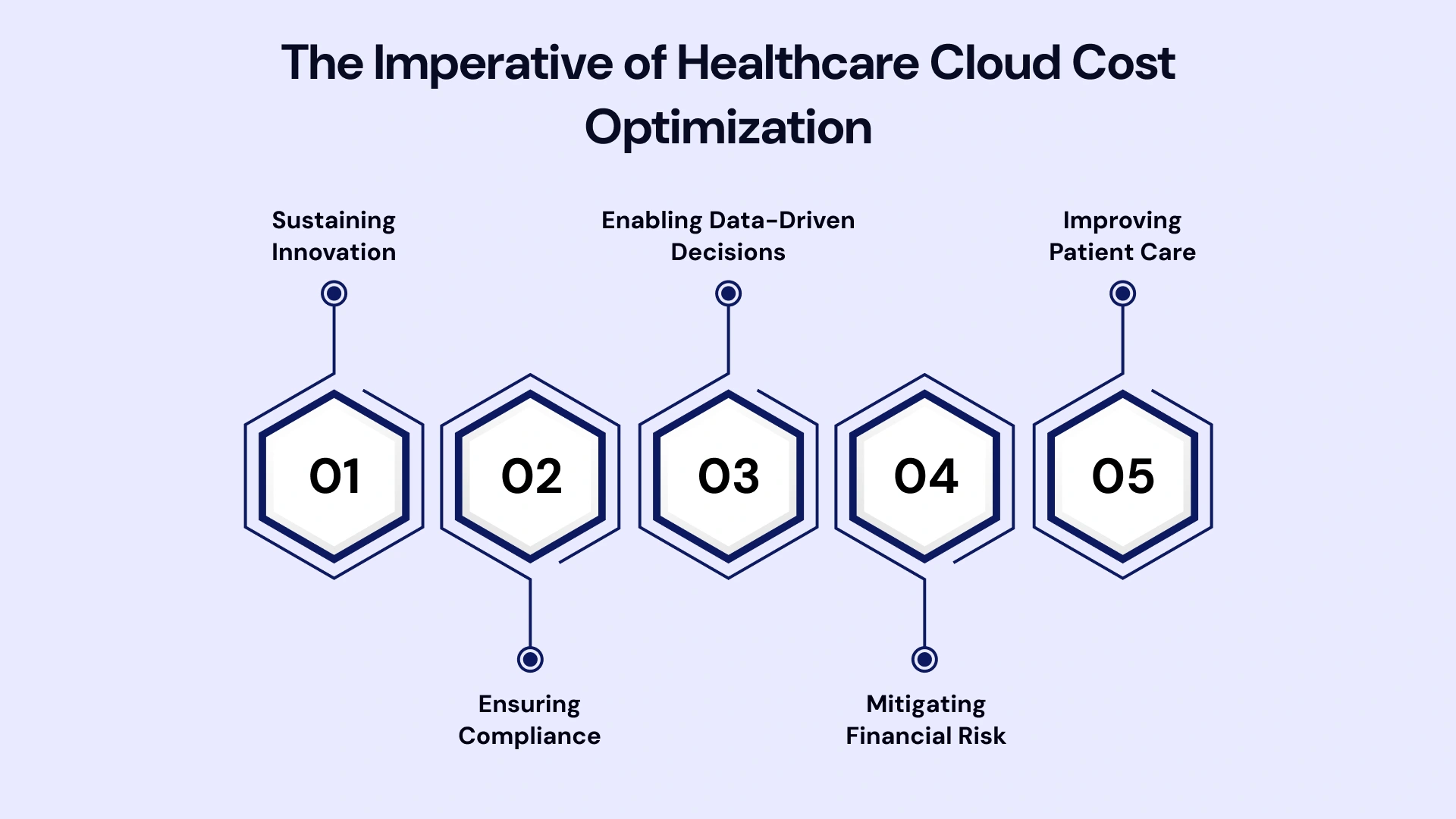
- Sustaining Innovation: Providing the financial headroom for essential projects like EHR modernization, supporting remote patient monitoring, and enhancing telemedicine scalability.
- Ensuring Compliance: Facilitating a HIPAA-compliant cloud cost optimization solution and adherence to Canadian provincial data sovereignty laws by correctly provisioning and monitoring services.
- Enabling Data-Driven Decisions: Gaining real-time healthcare cloud spend visibility and monitoring to enable rapid, informed, and strategic financial decisions.
- Mitigating Financial Risk: The variable-spend nature of the cloud can lead to uncontrolled escalation if not actively managed. Proactive cloud cost control for hospitals mitigates the risk of sudden, unexpected spikes in operating expenses.
- Improving Patient Care: Every dollar saved on inefficient IT infrastructure transformation can be reallocated to hiring more frontline staff, investing in cutting-edge diagnostic equipment, or expanding access to underserved communities, directly improving patient care with cloud cost savings.
Key Statistics: The Rising Tide of Cloud Expenses
The scale of this challenge underscores its urgency:
Core Drivers for Healthcare Cloud Cost Optimization
The unique operating model of healthcare—characterized by cyclical patient demand, massive data volumes, and stringent regulatory requirements—makes proactive cost management essential.
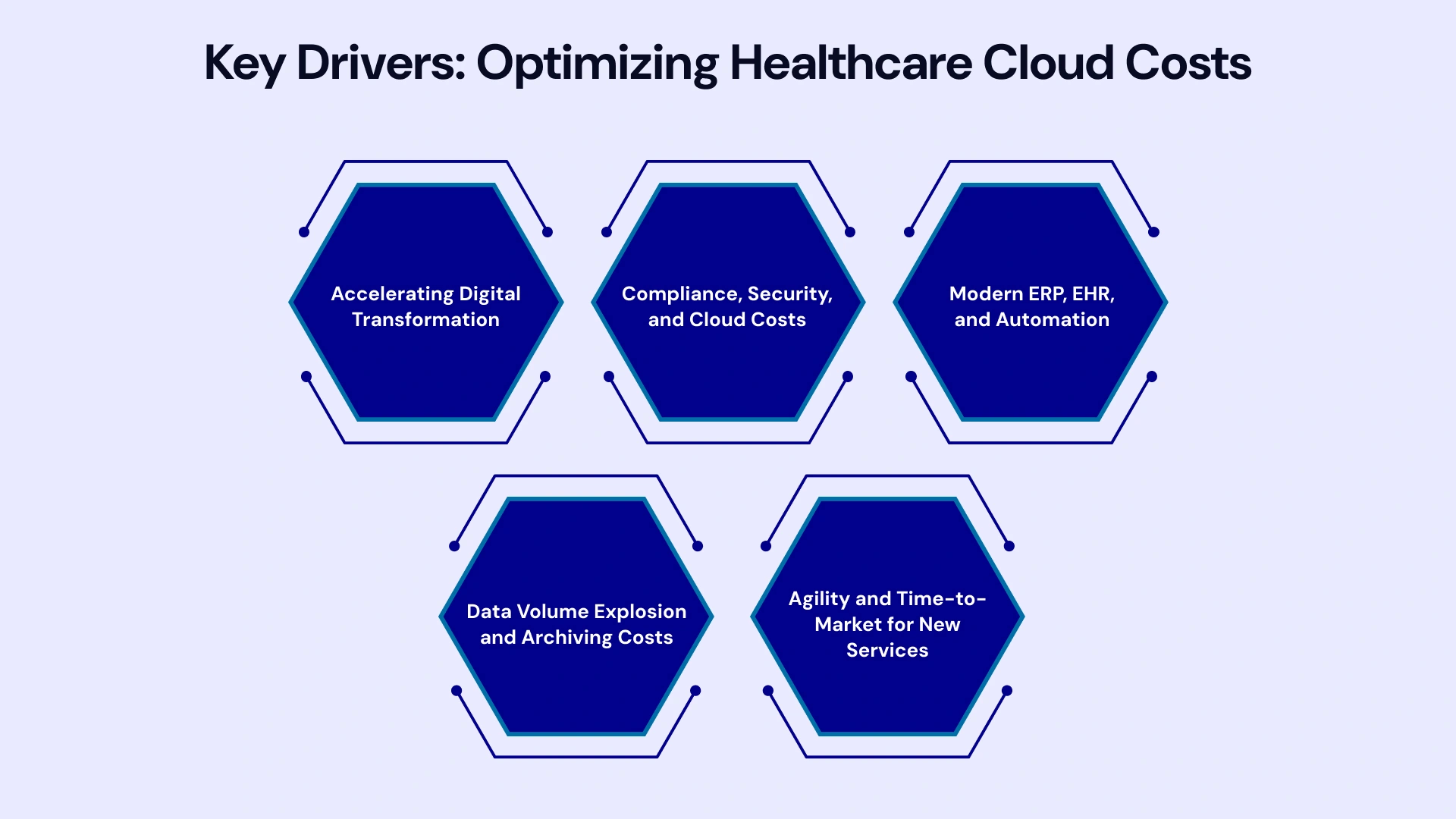
Accelerating Digital Transformation
The role of Cloud computing in healthcare is the foundation for all modern digital health initiatives, including AI diagnostics, high-resolution digital imaging, and seamless data interoperability.
This acceleration often involves complex hybrid and multi-cloud architectures, which, while offering resilience and flexibility, necessitate the use of advanced cloud cost optimization solution tools for hospitals and clinics to manage a distributed and rapidly changing environment.
Compliance, Security, and Cloud Costs
Regulatory frameworks, such as HIPAA in the US and similar provincial data protection laws in Canada (e.g., PHIPA in Ontario), require secure cloud cost management in healthcare. Maintaining this security posture—which involves encryption, access controls, and auditing—involves cost.
Selecting inherently compliant services, maintaining continuous monitoring, and ensuring that all relevant vendors sign healthcare cloud Business Associate Agreements (BAAs) are non-negotiable for safeguarding patient data and controlling long-term costs. The goal is healthcare cloud compliance and cost control without compromise.
Modern ERP, EHR, and Automation
Modernizing core administrative systems is a major driver of cloud costs and savings. The adoption of cloud-native ERP in healthcare, combined with the integration of automation tools, is a proven strategy for enhancing the cost efficiency of healthcare IT in the cloud.
These systems prevent resource overprovisioning, dynamically allocate resources based on need (e.g., during peak registration times), and drastically cut the manual overhead for IT and finance teams. This shift supports cloud cost savings with EHR modernization projects.
Data Volume Explosion and Archiving Costs
The sheer volume of patient data, especially high-resolution medical images and genomic data, demands scalable storage. Effective healthcare cloud infrastructure optimization requires moving less frequently accessed data to lower-cost archival tiers. Managing this data lifecycle, including retention policies for compliance, is a critical component of managing cloud expenses in healthcare.
Agility and Time-to-Market for New Services
Cloud enables rapid deployment of new services (e.g., a COVID-19 screening app or a new AI diagnostic tool). While this agility is crucial, rapid provisioning without proper cloud governance in healthcare organizations can lead to immediate, untracked costs. Cloud FinOps in healthcare ensures that speed does not compromise financial control, striking a balance between innovation and fiscal responsibility.
Best Practices for Cloud Cost Control in Healthcare
Achieving sustainable cloud cost control for hospitals requires a structured, multi-disciplinary approach that integrates finance, technology, and clinical operations.
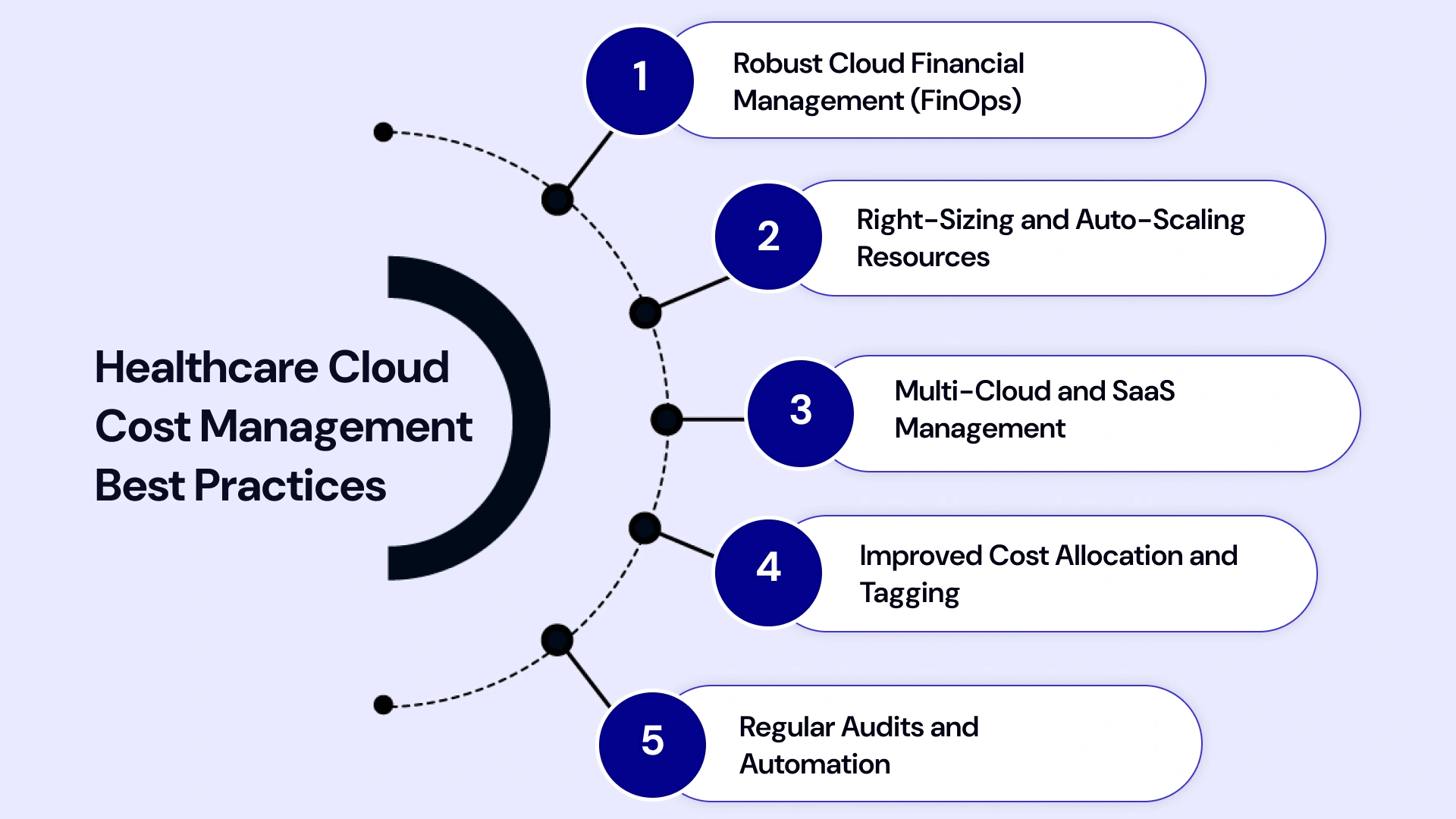
1. Robust Cloud Financial Management (FinOps)
FinOps is a cultural practice that brings financial accountability to the variable spend model of the cloud. Cloud FinOps in healthcare involves integrating financial, operational, and clinical stakeholders for continuous cost assessment, meticulous resource tagging, and spend accountability.
- Foster a Culture of Cost-Consciousness: Ensure skilled software developers and clinical application owners understand the financial implications of their technical decisions.
- Transparency and Showback: Implement real-time dashboards to offer transparency, empowering decision-makers to track and control healthcare cloud infrastructure optimization efforts and costs in their specific domains.
- Centralized Strategy: The FinOps team must drive the overall strategy for managing cloud expenses in healthcare, ensuring consistency across departments.
2. Right-Sizing and Auto-Scaling Resources
One of the quickest paths to cloud cost savings is eliminating idle or over-provisioned resources. Right-sizing involves adjusting compute, storage, and network allocations to match real-time demand, which has been proven to reduce waste by 25–35%.
- Auto-Scaling: Implement dynamic auto-scaling to handle sudden demand spikes (e.g., during a telehealth surge or a major billing cycle) while ensuring resources automatically scale back down during periods of low demand.
- Reserved and Spot Instances: Leverage reserved instances or savings plans for predictable, continuous workloads (like core ERP in healthcare systems) to secure substantial discounts. Utilize low-cost spot instances for non-critical or batch processing tasks.
3. Multi-Cloud and SaaS Management
Many healthcare organizations use multiple cloud providers (AWS, Azure, GCP) and numerous SaaS solutions. Managing multi-cloud costs in healthcare organizations is vital to mitigate vendor lock-in and enable optimization through competition and specialized service selection.
- Unified Monitoring: Employ cloud cost management software and tools (such as native cloud provider tools like AWS Cost Explorer, Azure Cost Management, Google Billing Reports, or third-party platforms like CloudHealth) to centralize monitoring, healthcare cloud cost forecasting, and governance across all environments.
- SaaS Audit: Regularly audit SaaS subscriptions to ensure licenses are being used efficiently and eliminate "shelfware"—paid licenses that are unused.
4. Improved Cost Allocation and Tagging
The accuracy of cost management hinges on accurate cost allocation.
- Mandatory Tagging: Deploy robust tagging strategies to precisely track cloud usage by department, service line, or specific application (e.g., EHR modernization project, imaging archive, telemedicine platform).
- Accountability: Comprehensive tagging supports both healthcare cloud compliance and cost control, fostering accountability across business units and pinpointing specific areas for cost reduction.
5. Regular Audits and Automation
Manual governance cannot keep pace with the scale of modern cloud deployments.
- Prevent Shadow IT: Schedule frequent, automated audits to identify unused or idle resources and prevent "Shadow IT"—unauthorized resources that spiral costs. Maintain strong visibility and monitoring of healthcare cloud spend.
- Automated Governance: Establish healthcare cloud automation for cost efficiency by implementing auto-shutdown scripts for non-production environments after hours, budget threshold alerts, and continuous compliance checks.
AWS vs. Azure vs. GCP: Choosing for Healthcare Cloud Cost Management
Selecting the right cloud provider (AWS, Azure, or GCP) is foundational to effective cloud cost management in healthcare. All major hyperscalers offer enterprise-grade capabilities, but their pricing models, specific tools, and ecosystem strengths differ.
| Feature/Cloud Platform | AWS | Azure | Google Cloud Platform (GCP) |
| Cloud cost optimization tools | AWS Cost Explorer, Compute Optimizer, Trusted Advisor. | Azure Cost Management, Azure Advisor. | Google Billing Reports, Cost Management APIs. |
| Healthcare compliance/HIPAA support | Mature, dedicated healthcare solutions, widely-adopted BAAs. | A strong healthcare portfolio, native compliance tools, and a robust hybrid capability. | Advanced security, strong AI/ML tools for clinical data analysis. |
| Automation & scaling features | Mature auto-scaling, Reserved Instances, Savings Plans. | Robust scaling, excellent for hybrid integration with on-premises data centers. | Superior for big data, flexible scaling, and AI/ML add-ons. |
| Cost control/forecasting integration | Advanced, integrates seamlessly with third-party FinOps solutions. | Strong visualization, seamless integration with the Microsoft ecosystem. | Granular resource and spend projections, strong API integration. |
The final decision often hinges on past IT investments (e.g., existing Microsoft licensing), the availability of specific cloud cost optimization technique tools, the details of the BAAs, and integration with existing healthcare software development services.
Healthcare Cloud Cost Optimization: Real-World Examples
The principles of cloud cost management in healthcare translate directly into significant savings and operational improvements:
- Mid-sized Hospital Network: Implemented robust tagging and strategic reserved instance purchases for their core patient data warehouses, resulting in an annual reduction of cloud expenses by 30%.
- Telemedicine Provider (US/Canada): Leveraged auto-scaling and spot instances for their non-critical video processing workloads and batch analytics, saving over $500,000 annually while strictly maintaining HIPAA-compliant cloud cost optimization.
- Major Health Network: Deployed advanced cost management dashboards, reducing the time spent on manual cost management by 70% and identifying over $40,000 per month in potential savings by flagging underutilized compute resources.
- Nonprofit Medical Research Group: Migrated their lab systems to Azure with managed services, achieving a 48% reduction in IT cloud costs and establishing a 97% compliant state, demonstrating that cost savings and security can be achieved simultaneously.
Solutions and Tools for Managing Cloud Expenses in Healthcare
Effective management of cloud expenses in healthcare requires powerful, intelligent tooling that goes beyond simple billing reports.
Leading Cloud Cost Management Software
- Native Tools: AWS Cost Explorer, Azure Cost Management, and Google Cloud Billing Reports provide the essential foundation for visibility, forecasting, and native optimization recommendations.
Multi-Cloud FinOps Platforms:
- CloudHealth by VMware: Offers multi-cloud optimization, policy-based controls, and detailed compliance reporting necessary for healthcare cloud financial management.
- Harness/CloudZero: Provides deep, actionable cost intelligence by mapping spend to specific features, teams, or patients, offering real-time spend mapping and anomaly detection.
- IBM Turbonomic: Utilizes AI-driven optimization, load balancing, and automated cloud governance in healthcare organizations to ensure resources are always perfectly matched to demand.
- Specialized Healthcare Cost Tools: Tools that integrate directly with EHR or PACS systems to track and optimize costs per patient record, per image, or per clinical outcome, tying infrastructure spend directly to clinical value.
These platforms are essential for driving maximum healthcare IT cloud cost efficiency and realizing the true ROI of cloud cost management in healthcare.
Healthcare Cloud Cost Savings Strategies
To ensure sustained savings, organizations must integrate the following strategies:
- Continual Rightsizing: Treat rightsizing as an ongoing process, not a one-time event, continually adjusting instances and storage based on historical workload data to avoid overprovisioning.
- Automation First: Leverage healthcare cloud automation for cost efficiency for resource scaling, scheduling, and the automated elimination of idle resources (e.g., development/test environments after business hours).
- Proactive Planning: Centralize spend monitoring and utilize healthcare cloud cost forecasting for proactive budgeting and planning, ensuring financial stakeholders are never surprised by the cloud bill.
- Strategic Procurement: Negotiate multi-year or usage-based contracts, such as reserved instances or savings plans, to access significant volume discounts from cloud providers.
- Hybrid Efficiency: Integrate cloud and on-premise solutions strategically for flexible, hybrid healthcare cloud infrastructure optimization, placing non-critical or legacy workloads where they are most cost-effective.
- Data Tiering and Lifecycle Management: Implement policies to automatically migrate cold patient data from expensive primary storage to archival tiers, significantly reducing IT operational costs in healthcare cloud storage.
Healthcare Cloud Compliance and Secure Cost Management
A cornerstone of cloud cost management in healthcare is the absolute requirement for security and compliance. HIPAA-compliant cloud cost optimization dictates that robust encryption, strict access controls, BAA maintenance, and real-time threat detection must be built into every cost reduction step.
The Intersect of Compliance and Cost
Compliance activities can be both a driver of cost and a source of savings.
- Cost Drivers: Implementing necessary controls (e.g., enhanced logging, multi-factor authentication, data encryption at rest and in transit) adds to the service consumption bill. Regular auditing and reporting also consume resources.
- Cost Savings: Proactive, automated compliance significantly reduces the risk of substantial fines associated with HIPAA compliance checklist or HITECH violations in the US, as well as breaches of provincial data protection laws in Canada. The cost of a breach far outweighs the cost of compliance.
Secure Cloud Cost Management in Healthcare
To ensure secure cloud cost management in healthcare, organizations must follow rigorous practices:
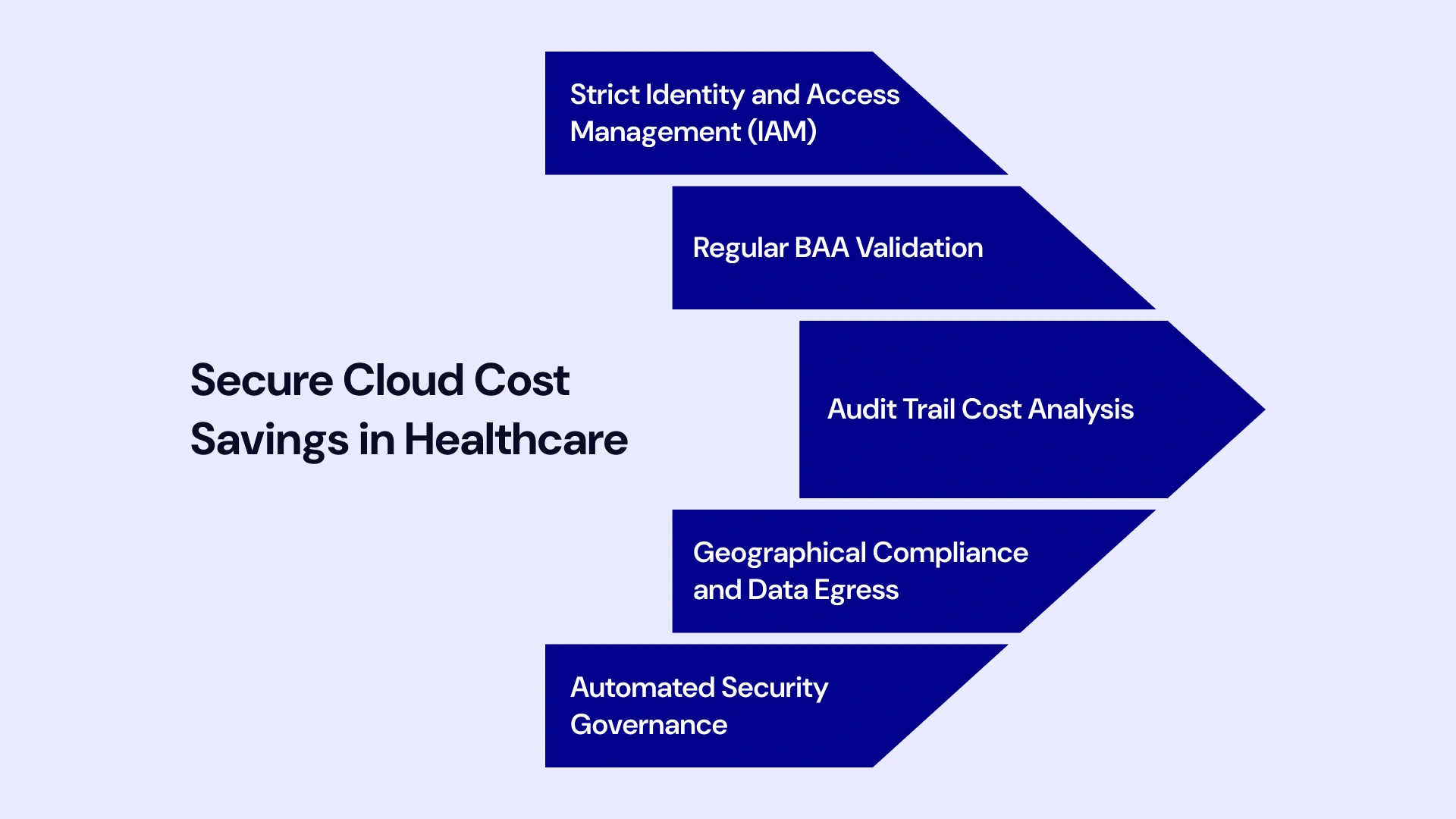
- Strict Identity and Access Management (IAM): Implement the principle of least privilege. Granting overly permissive access can lead to costly misuse, unauthorized resource spin-up, and potential security vulnerabilities.
- Regular BAA Validation: Ensure all third-party providers involved in cloud cost optimization solutions or management (especially those with access to configuration data that might contain PHI context) are covered by a current healthcare cloud BAA.
- Audit Trail Cost Analysis: Configure cloud logging and audit trails not just for compliance, but also to identify anomalous spending spikes that could indicate security threats or unauthorized activity.
- Geographical Compliance and Data Egress: Be mindful of data residency requirements (critical in Canada) and the high costs associated with data egress. Healthcare cloud infrastructure optimization should prioritize in-region data processing and minimize data transfer to keep costs low while maintaining high compliance.
Automated Security Governance: Utilize automated tools to enforce security configurations and budget policies simultaneously. For example, an automation script can ensure a developer's environment is shut down at 6 PM and verify that all storage volumes are encrypted, ensuring both cloud security and cost management for healthcare providers.
VLink: Maximize Healthcare Cloud Savings
To navigate the complex intersection of cloud cost management, compliance, and innovation in healthcare, partnering with a specialized expert is crucial. VLink offers tailored cloud optimization services and healthcare software development services specifically designed for the stringent requirements of the US and Canadian healthcare markets.
VLink's Approach to Optimized Density and Cost Control:
- HIPAA Compliant Cloud Cost Optimization Framework: We begin with a compliance-first cost assessment, ensuring every optimization step adheres to HIPAA, PHIPA, and other regional mandates. Our strategy ensures healthcare HIPAA-compliant cloud cost management is foundational, not an afterthought.
- Predictive Healthcare Cloud Cost Forecasting: Utilizing advanced AI and machine learning, we go beyond simple linear projections. Our dedicated team analyzes seasonal patient load, legislative changes, and new service rollouts to provide granular healthcare cloud cost forecasting accuracy, enabling proactive budget adjustments.
- FinOps Maturity Roadmap: We implement a comprehensive Cloud FinOps model in healthcare, establishing the culture, tools, and governance necessary to drive financial accountability across your organization, ensuring sustainable healthcare cloud costs.
- Multi-Cloud Cost Aggregation and Policy: Our expertise in managing multi-cloud costs for healthcare organizations provides a single pane of glass for monitoring AWS, Azure, and GCP, recommending the most cost-effective provider for each specific workload (e.g., utilizing GCP for specialized AI analytics while maintaining EHR on Azure).
- Automation for Efficiency and Security: We deploy custom healthcare cloud automation to achieve cost efficiency, including automated right-sizing, schedule-based shutdowns, and continuous compliance checks, thereby reducing IT operational costs in the healthcare cloud without compromising security.
Contact VLink today to transition from simply tracking your cloud bill to actively managing your healthcare cloud financial strategy.
Wrap Up!
Cloud cost management in healthcare is the new strategic imperative for financial sustainability in the US and Canada. As digital demands from EHRs to AI drive cloud spending higher, meticulous healthcare cloud cost optimization techniques are mandatory for continued innovation.
Achieving this requires a committed shift to Cloud FinOps and strong cloud governance, effectively integrating cost control with strict regulatory compliance. By deploying automated best practices and expert services, providers ensure cloud resources deliver maximum patient value.
The result is secure cloud cost management that directly unlocks capital, allowing funds to be reinvested in enhancing patient care. For healthcare leaders, embracing cost control is the critical step toward leading the next generation of digital health.
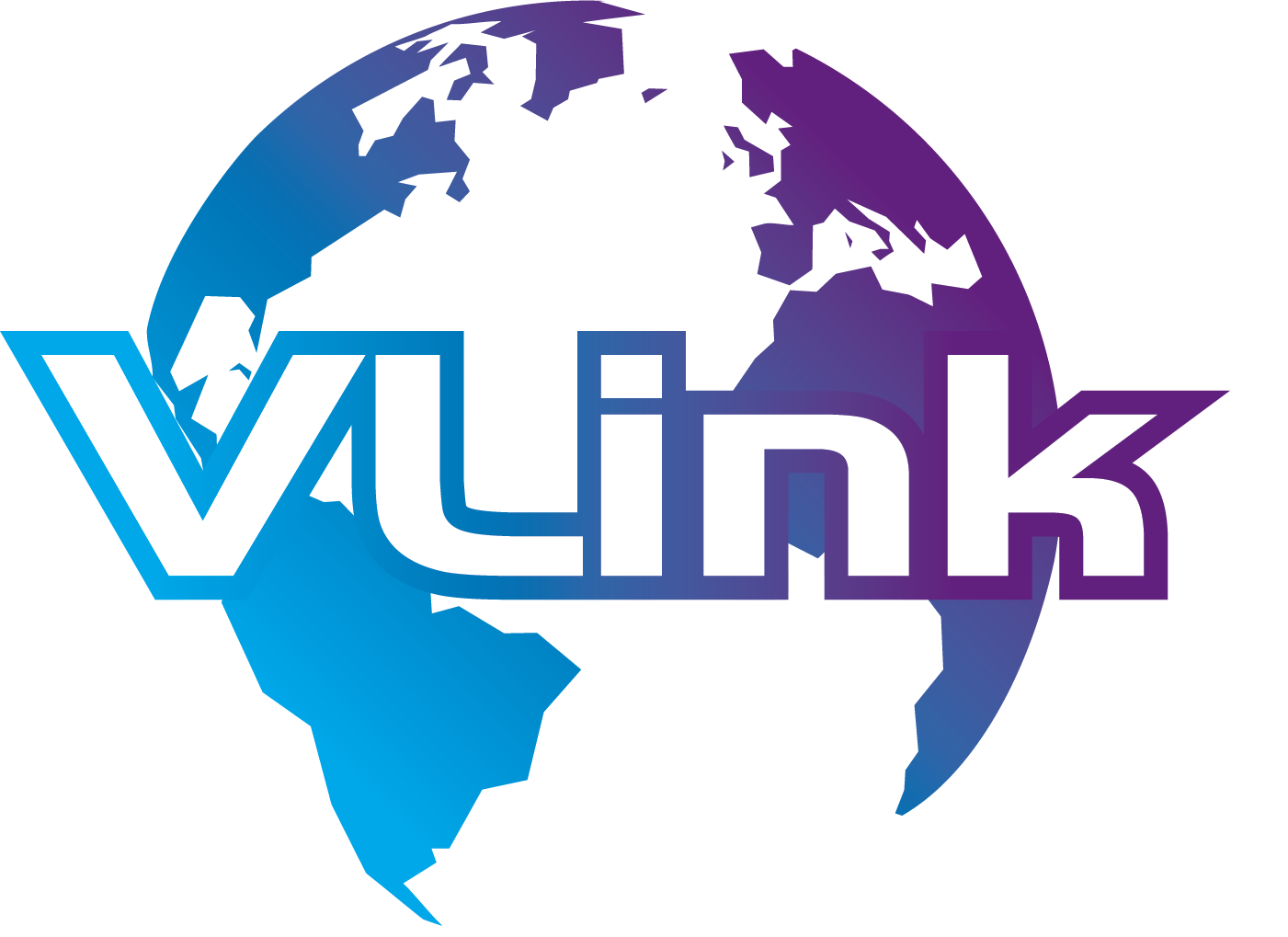









 Shivisha Patel
Shivisha Patel
















